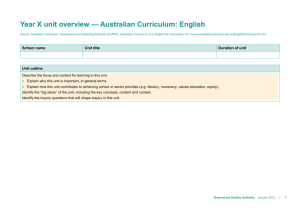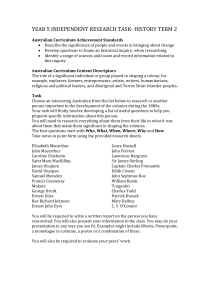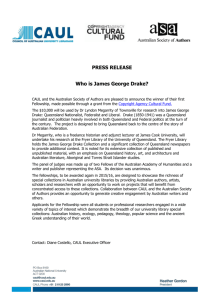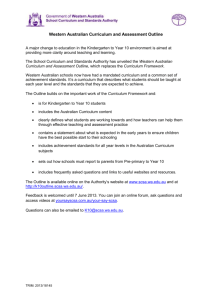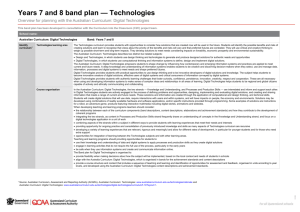Prep Year to Year 2 band plan * Digital Technologies
advertisement
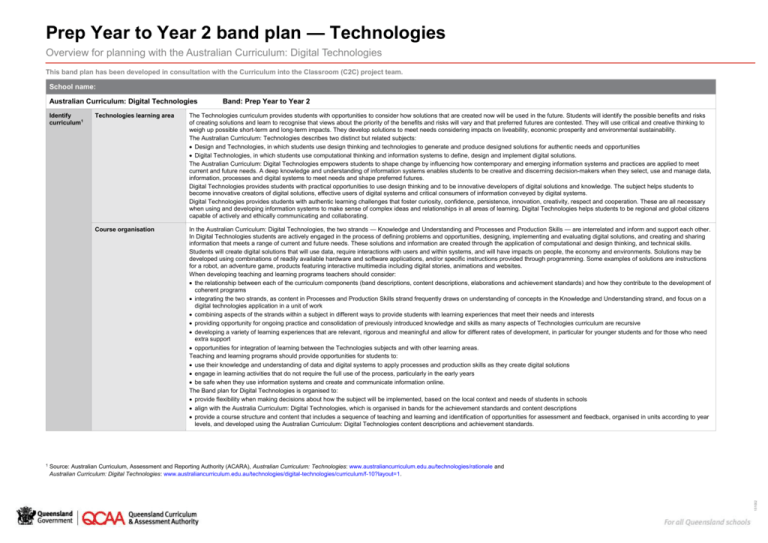
Prep Year to Year 2 band plan — Technologies Overview for planning with the Australian Curriculum: Digital Technologies This band plan has been developed in consultation with the Curriculum into the Classroom (C2C) project team. School name: Australian Curriculum: Digital Technologies Identify curriculum1 Technologies learning area The Technologies curriculum provides students with opportunities to consider how solutions that are created now will be used in the future. Students will identify the possible benefits and risks of creating solutions and learn to recognise that views about the priority of the benefits and risks will vary and that preferred futures are contested. They will use critical and creative thinking to weigh up possible short-term and long-term impacts. They develop solutions to meet needs considering impacts on liveability, economic prosperity and environmental sustainability. The Australian Curriculum: Technologies describes two distinct but related subjects: Design and Technologies, in which students use design thinking and technologies to generate and produce designed solutions for authentic needs and opportunities Digital Technologies, in which students use computational thinking and information systems to define, design and implement digital solutions. The Australian Curriculum: Digital Technologies empowers students to shape change by influencing how contemporary and emerging information systems and practices are applied to meet current and future needs. A deep knowledge and understanding of information systems enables students to be creative and discerning decision-makers when they select, use and manage data, information, processes and digital systems to meet needs and shape preferred futures. Digital Technologies provides students with practical opportunities to use design thinking and to be innovative developers of digital solutions and knowledge. The subject helps students to become innovative creators of digital solutions, effective users of digital systems and critical consumers of information conveyed by digital systems. Digital Technologies provides students with authentic learning challenges that foster curiosity, confidence, persistence, innovation, creativity, respect and cooperation. These are all necessary when using and developing information systems to make sense of complex ideas and relationships in all areas of learning. Digital Technologies helps students to be regional and global citizens capable of actively and ethically communicating and collaborating. Course organisation In the Australian Curriculum: Digital Technologies, the two strands — Knowledge and Understanding and Processes and Production Skills — are interrelated and inform and support each other. In Digital Technologies students are actively engaged in the process of defining problems and opportunities, designing, implementing and evaluating digital solutions, and creating and sharing information that meets a range of current and future needs. These solutions and information are created through the application of computational and design thinking, and technical skills. Students will create digital solutions that will use data, require interactions with users and within systems, and will have impacts on people, the economy and environments. Solutions may be developed using combinations of readily available hardware and software applications, and/or specific instructions provided through programming. Some examples of solutions are instructions for a robot, an adventure game, products featuring interactive multimedia including digital stories, animations and websites. When developing teaching and learning programs teachers should consider: the relationship between each of the curriculum components (band descriptions, content descriptions, elaborations and achievement standards) and how they contribute to the development of coherent programs integrating the two strands, as content in Processes and Production Skills strand frequently draws on understanding of concepts in the Knowledge and Understanding strand, and focus on a digital technologies application in a unit of work combining aspects of the strands within a subject in different ways to provide students with learning experiences that meet their needs and interests providing opportunity for ongoing practice and consolidation of previously introduced knowledge and skills as many aspects of Technologies curriculum are recursive developing a variety of learning experiences that are relevant, rigorous and meaningful and allow for different rates of development, in particular for younger students and for those who need extra support opportunities for integration of learning between the Technologies subjects and with other learning areas. Teaching and learning programs should provide opportunities for students to: use their knowledge and understanding of data and digital systems to apply processes and production skills as they create digital solutions engage in learning activities that do not require the full use of the process, particularly in the early years be safe when they use information systems and create and communicate information online. The Band plan for Digital Technologies is organised to: provide flexibility when making decisions about how the subject will be implemented, based on the local context and needs of students in schools align with the Australia Curriculum: Digital Technologies, which is organised in bands for the achievement standards and content descriptions provide a course structure and content that includes a sequence of teaching and learning and identification of opportunities for assessment and feedback, organised in units according to year levels, and developed using the Australian Curriculum: Digital Technologies content descriptions and achievement standards. Source: Australian Curriculum, Assessment and Reporting Authority (ACARA), Australian Curriculum: Technologies: www.australiancurriculum.edu.au/technologies/rationale and Australian Curriculum: Digital Technologies: www.australiancurriculum.edu.au/technologies/digital-technologies/curriculum/f-10?layout=1. 151002 1 Band: Prep Year to Year 2 The Band plan course organisation allows schools to implement the Australian Curriculum: Digital Technologies in: conjunction with other learning areas/subjects a term a semester only one year of a band of years. Safety All practical work must be organised with student safety in mind. Identifying and managing risk in Technologies learning addresses the safe use of technologies, as well as risks that can impact on project timelines. It covers all necessary aspects of health, safety and injury prevention and, in any technologies context, the use of potentially dangerous materials, tools and equipment. It includes ergonomics, safety including cyber safety, data security, and ethical and legal considerations when communicating and collaborating online. The current safety requirements are clearly explained on the Queensland Government Education Health and Safety webpage: http://education.qld.gov.au/health/safety. School must ensure that their practices meet current guidelines. Animal ethics Any teaching activities that involve caring, using, or interacting with animals must comply with the Australian code of practice for the care and use of animals for scientific purposes in addition to relevant state or territory guidelines. The Animal Care and Protection Act 2001 and the accompanying Animal Care and Protection Regulation 2002 govern the treatment and use of all animals in Queensland (see www.legislation.qld.gov.au). The Department of Agriculture, Fisheries and Forestry Queensland (DAFF), through Biosecurity Queensland, is responsible for enforcement of the legislation. Teaching and learning Phase curriculum focus Curriculum focus: Prep Year to Year 2 Students bring to school diverse backgrounds and a range of experiences with technologies. The Technologies curriculum builds on these as rich resources for further learning in each of the Technologies subjects. In Foundation to Year 2, the Technologies curriculum builds on the Early Years Learning Framework and its key learning outcomes: children have a strong sense of identity; children are connected with, and contribute to, their world; children have a strong sense of wellbeing; children are confident and involved learners; and children are effective communicators. In the early years students are curious about their world and are interested in exploring it. In Technologies, students have opportunities to learn through purposeful and directed play to develop attitudes of care about the places and resources they use. Through these processes they identify relationships between imagined and virtual worlds and the real world, between people and products, and between resources and environments (systems thinking). They explore materials, tools and equipment and use drawing and modelling to communicate their design ideas. Students learn about and experience connections between technologies and the designed world (design thinking). They begin to learn the importance of preparing precise instructions when solving problems using digital systems (computational thinking), creating ideas and information and sharing them online with known people. In Design and Technologies and Digital Technologies, children create imaginary situations in which they change the meaning of objects and actions as they invent new ideas and engage in futures thinking (for them). They also explore real-world concepts, rules and events as they role-play what is familiar and of interest to them. Band description Learning in Digital Technologies builds on concepts, skills and processes developed in the Early Years Learning Framework. It focuses on developing foundational skills in computational thinking and an awareness of personal experiences using digital systems. By the end of Year 2, students will have had opportunities to create a range of digital solutions through guided play and integrated learning, such as using robotic toys to navigate a map or recording science data with software applications. In Foundation to Year 2, students begin to learn about common digital systems and patterns that exist within data they collect. Students organise, manipulate and present this data, including numerical, categorical, text, image, audio and video data, in creative ways to create meaning. Students use the concept of abstraction when defining problems, to identify the most important information, such as the significant steps involved in making a sandwich. They begin to develop their design skills by conceptualising algorithms as a sequence of steps for carrying out instructions, such as identifying steps in a process or controlling robotic devices. Students describe how information systems meet information, communication and/or recreational needs. Through discussion with teachers, students learn to apply safe and ethical practices to protect themselves and others as they interact online for learning and communicating. Achievement standard By the end of Year 2, students identify how common digital systems (hardware and software) are used to meet specific purposes. They use digital systems to represent simple patterns in data in different ways. Students design solutions to simple problems using a sequence of steps and decisions. They collect familiar data and display them to convey meaning. They create and organise ideas and information using information systems and share information in safe online environments. Unit overview The Australian Curriculum assumes that all students will study the two Technologies subjects from Foundation to the end of Year 8. Schools decide which units of study per subject to complete, and how and when. This band plan provides one potential unit. Unit 1 — Computers: Handy helpers Children will learn and apply Digital Technologies knowledge and skills through guided play and tasks integrated into other subject areas. Children will: explore and describe how digital and information systems are used for particular purposes in daily life collect, explore and sort familiar data and use digital systems to present the data creatively to convey meaning describe, follow and apply a sequence of steps and decisions (algorithms) to solve problems in non-digital and digital contexts develop foundational skills in computational and systems thinking when solving problems work with others to create and organise ideas and information in a safe online environment develop foundational skills in computational thinking, applying strategies such as exploring patterns, developing logical steps and hiding unnecessary information. Prep Year to Year 2 band plan — Technologies Overview for planning with the Australian Curriculum: Digital Technologies Queensland Curriculum & Assessment Authority November 2015 Page 2 of 3 Content descriptions Knowledge and Understanding Unit 1 Identify, use and explore digital systems (hardware and software components) for a purpose (ACTDIK001) Recognise and explore patterns in data and represent data as pictures, symbols and diagrams (ACTDIK002) Processes and Production Skills General capabilities Develop assessment Make judgments and use feedback Collect, explore and sort data, and use digital systems to present the data creatively (ACTDIP003) Follow, describe and represent a sequence of steps and decisions (algorithms) needed to solve simple problems (ACTDIP004) Explore how people safely use common information systems to meet information, communication and recreation needs (ACTDIP005) Work with others to create and organise ideas and information using information systems, and share these with known people in safe online environments (ACTDIP006) Literacy Numeracy ICT capability Critical and creative thinking Personal and social capability Assessment The Prep to Year 2 Technologies: Australian Curriculum in Queensland — assessment and reporting advice and guidelines brings together advice about assessment, making judgments and reporting in a single document. See www.qcaa.qld.edu.au/p10/aciq/p-10-technologies/prepyear-technologies > Prep to Year 2 Technologies: ACiQ. The assessment for this unit provides evidence of student learning and provides opportunities for teachers to make judgments about whether students have met the Australian Curriculum: Digital Technologies Foundation to Year 2 achievement standard. Children should contribute to an individual assessment folio that provides evidence of their learning and represents their achievements. The folio should include a range and balance of assessments for teachers to make valid judgments about whether the child has met the achievement standard. Assessment of student learning will be gathered in an online sharing space from three tasks. In at least one task, students will create and organise information using information systems and share information in a safe online environment. Consistency of teacher judgments Identify opportunities to moderate samples of student work at a school or cluster level to reach consensus and consistency. Unit 1 — Computers: Handy helpers The assessment will gather evidence of children’s ability to: identify common digital and information systems and explain the purposes of them in a voice recording by: identifying common digital and information systems explaining how the information system meets needs. create a class profile, using digital systems to present data in a creative way to create meaning by: collecting familiar data organising data to create meaning using an information system displaying data to create meaning. design steps (algorithm) to direct a person or object (such as floor robot, character in a simple visual program or person) to navigate a path by: following and describing a series of steps planning a route designing a path using simple symbols (algorithm). Prep Year to Year 2 band plan — Technologies Overview for planning with the Australian Curriculum: Digital Technologies Queensland Curriculum & Assessment Authority November 2015 Page 3 of 3




